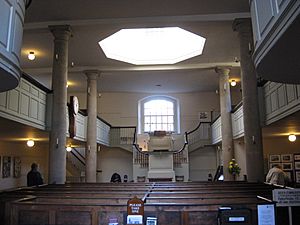John Wesley's New Room facts for kids
Quick facts for kids John Wesley's New Room |
|
|---|---|

Statue of John Wesley with the New Room behind
|
|
| 51°27′28″N 2°35′24″W / 51.4579°N 2.5901°W | |
| Location | 36 The Horsefair, Bristol, England, |
| Denomination | Methodist |
| History | |
| Founder(s) | John Wesley |
| Architecture | |
| Completed | May 1739 |
John Wesley's New Room is a very old building in Bristol, England. It is located between The Horsefair and Broadmead. It opened in June 1739 and was home to the first groups of Methodists. The building was made bigger in 1748.
It is the oldest building made just for Methodist worship in Great Britain. Because it is so important, Historic England has recognized it as a Grade I listed building. Today, there is a museum about Methodism in the rooms above the chapel where preachers used to stay. Outside, in the courtyards, you can see statues of John Wesley and his brother, Charles.
Contents
The Story of John Wesley's New Room
On April 2, 1739, John Wesley began preaching outdoors in Bristol. He also created groups of followers there. Just two months later, Wesley helped build this chapel. It became the oldest building in the world made specifically for Methodist worship. He called it "our New Room in the Horsefair."
Building Features and Early Uses
The chapel was built with a special double-decker pulpit, which was common back then. It has an eight-sided window at the top to let in light. This design also helped reduce the amount of window tax they had to pay. Besides being a place for meetings and worship, the New Room was also used as a clinic and a school. It helped poor people in the area. The seats and benches inside were made from old ship timber.
Two Methodist groups, the Baldwin and Nicholas Street societies, joined together. They formed the United Society and met at the New Room starting June 3, 1739. Wesley wanted Methodism to work with the Church of England, not against it. So, he made sure meetings at the New Room only happened when Anglican churches were not holding services.
Expanding the New Room
In 1748, the building was made larger. It might have been designed by a Quaker architect named George Tully. This is because it looks similar to another building he designed nearby. John Wesley believed that formal worship should happen in churches. He only allowed the bigger New Room to become a formal place of worship with some hesitation. This change followed the Toleration Act 1688.
Rooms were built above the chapel. Wesley and other traveling preachers stayed in these rooms. Wesley himself lived at the New Room from 1748 to 1771. He led Holy Communion services there when his brother Charles was away. Wesley also sold his books from a bookstore in the New Room. This helped spread Methodist ideas in Bristol. He even published a medical handbook called Primitive Physick. The New Room had one of Bristol's first medical clinics, called a Dispensary.
Later Years and Modern Updates
After Wesley passed away, the property was taken over by the Welsh Calvinistic Methodists in 1808. Later, in 1929, the Wesleyan Methodist Church bought it back. A special organ, made by John Snetzler in 1761, was added in the 20th century. This happened after the building was restored in 1929 by Sir George Oatley.
On May 24, 2011, a new garden was opened in the Broadmead Courtyard. The Lord Mayor of Bristol officially opened it. Then, on July 13, 2017, the Horsefair Visitor Centre opened. The Duke of Gloucester was there for the opening. These new facilities include a café, a library, an archive, and spaces for conferences and education. There is also a bigger, interactive museum in the twelve rooms upstairs from the 1748 building. As the oldest purpose-built Methodist building in the world, it is now a popular place for people from all over to visit.
See also
- Charles Wesley's House (Bristol)
- Wesley's Chapel (London)
- Churches in Bristol
- Grade I listed buildings in Bristol



